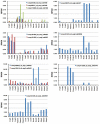Transcriptome-wide identification of microRNAs and functional insights inferred from microRNA-target pairs in Physalis angulata L
- PMID: 31184247
- PMCID: PMC6619950
- DOI: 10.1080/15592324.2019.1629267
Transcriptome-wide identification of microRNAs and functional insights inferred from microRNA-target pairs in Physalis angulata L
Abstract
Physalis angulata L., a member of the family Solanaceae, is widely used as the folk medicine in various countries. Continuous research efforts are devoted to the discovery of the effective medicinal ingredients from Physalis angulata. However, due to the limited resources of genome and transcriptome sequencing data, only a few studies have been performed at the gene regulatory level. In this study, the transcriptomes of five organs (roots, stems, leaves, flowers and fruits) of Physalis angulata were reported. Based on the transcriptome assembly containing 196,117 unique transcripts, a total of 17,556 SSRs (simple sequence repeats) were identified, which could be useful RNA-based barcoding for discrimination of the plants closely relative to Physalis angulata. Additionally, 24 transcripts were discovered to be the potential microRNA (miRNA) precursors which encode a total of 31 distinct mature miRNAs. Some of these precursors showed organ-specific expression patterns. Target prediction revealed 116 miRNA-target pairs, involving 31 miRNAs and 83 target transcripts in Physalis angulata. Taken together, our results could serve as the data resource for in-depth studies on the molecular regulatory mechanisms related to the production of medicinal ingredients in Physalis angulata.
Keywords: Organ-specific transcriptome; SSRs (simple sequence repeats); microRNA (miRNA); targets.
Figures



Similar articles
-
Complete Plastome of Physalis angulata var. villosa, Gene Organization, Comparative Genomics and Phylogenetic Relationships among Solanaceae.Genes (Basel). 2022 Dec 5;13(12):2291. doi: 10.3390/genes13122291. Genes (Basel). 2022. PMID: 36553558 Free PMC article.
-
The Physalis peruviana leaf transcriptome: assembly, annotation and gene model prediction.BMC Genomics. 2012 Apr 25;13:151. doi: 10.1186/1471-2164-13-151. BMC Genomics. 2012. PMID: 22533342 Free PMC article.
-
Identification of P450 Candidates Associated with the Biosynthesis of Physalin-Class Compounds in Physalis angulata.Int J Mol Sci. 2023 Sep 14;24(18):14077. doi: 10.3390/ijms241814077. Int J Mol Sci. 2023. PMID: 37762378 Free PMC article.
-
Physalis angulata Linn. as a medicinal plant (Review).Biomed Rep. 2024 Jan 24;20(3):47. doi: 10.3892/br.2024.1735. eCollection 2024 Mar. Biomed Rep. 2024. PMID: 38357237 Free PMC article. Review.
-
The use of high-throughput sequencing methods for plant microRNA research.RNA Biol. 2015;12(7):709-19. doi: 10.1080/15476286.2015.1053686. RNA Biol. 2015. PMID: 26016494 Free PMC article. Review.
Cited by
-
Chemical Composition Analysis, Cytotoxic, Antimicrobial and Antioxidant Activities of Physalis angulata L.: A Comparative Study of Leaves and Fruit.Molecules. 2022 Feb 22;27(5):1480. doi: 10.3390/molecules27051480. Molecules. 2022. PMID: 35268579 Free PMC article.
-
Advances in Physalis molecular research: applications in authentication, genetic diversity, phylogenetics, functional genes, and omics.Front Plant Sci. 2024 Jun 27;15:1407625. doi: 10.3389/fpls.2024.1407625. eCollection 2024. Front Plant Sci. 2024. PMID: 38993935 Free PMC article. Review.
References
-
- Gao CY, Ma T, Luo J, Kong LY. Three new cytotoxic withanolides from the Chinese folk medicine Physalis angulata. Nat Prod Commun. 2015;10:2059–2062. - PubMed
Publication types
MeSH terms
Substances
LinkOut - more resources
Full Text Sources
Other Literature Sources
